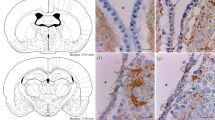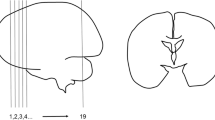Summary
Intercellular canaliculi surrounded by several ependymal cells, having numerous microvilli and a few cilia on the apical surface, are present throughout the frog median eminence. The intercellular canaliculi penetrate deeply near the portal vessel from the third ventricle. They are separated from the pericapillary space only by the thin cytoplasm of the ependymal cell.
The cytoplasmic protrusions containing a large number of clear vesicles are often found at the apical surface of ependymal cells facing the third ventricle or the lumen of intercellular canaliculus. The ependymal cell shows well developed Golgi apparatus and well developed rough endoplasmic reticulum in its cytoplasm. Dense granules of about 1200–1500 A diameter suggesting secretory materials are found in small number near the Golgi apparatus and abundantly in the ependymal process lying around the portal vessel.
Synaptic contacts between the ependymal cell and two different types of the nerve endings, monoaminergic and peptidergic, are frequently observed. A few small flasklike caveolae suggesting micropinocytosis are found in the post-synaptic membrane as well as in the lateral and basal plasma membranes of the ependymal cell. The author consideres that the ependymal cell in this region has secretory and transport (absorption) activities.
Similar content being viewed by others
References
Brightman, M. W., Reese, T. S.: Junctions between intimately apposed cell membranes in the vertebrate brain. J. Cell Biol.40, 648–677 (1969).
Knowles, F. G. W., Vollrath, L.: A functional relationship between neurosecretory fibers and pituicytes in the eel. Nature (Lond.)208, 1343 (1965).
— —: Neurosecretory innervation of the pituitary of the eelsAnguilla andConger. Phil. Trans. B250, 311–342 (1966).
Kobayashi, H., Matsui, T., Ishii, S.: Functional electron microscopy of the hypothalamic median eminence. Int. Rev. Cytol.29, 281–381 (1970).
Leveque, T. F., Hofkin, G. A.: Demonstration of an alcohol-chloroform insoluble, periodic acid Schiff reactive substance in the hypothalamus of the rat. Z. Zellforsch.53, 185–191 (1961).
—, Stutinsky, F., Porte, A., Stoeckel, M. E.: Morphologie fine d'une différentiation glandulaire du récessus infundibulaire chez le rat. Z. Zellforsch.69, 381–394 (1966).
Löfgren, F.: The infundibular recess, a component in the hypothalamo-adenohypophyseal system. Acta morphol. neerl.-scand.3, 55–78 (1960).
Matsui, T.: Fine structure of the posterior median eminence of the pigeon,Columba livia domestica. J. Fac. Sci., Univ. Tokyo, Sect. IV,11, 49–70 (1966a).
—: Fine structure of the median eminence of the rat. J. Fac. Sci., Univ. Tokyo, Sect. IV,11, 71–96 (1966b).
Rodriguez, E. M.: Ependymal specializations. I. Fine structure of the neural (internal) region of the toad median eminence, with particular reference to the connections between the ependymal cells and the subependymal capillary loops. Z. Zellforsch.102, 153–171 (1969).
Smoller, C. G.: Neurosecretory processes extending into third ventricle: Secretory or sensory? Science147, 882–884 (1964).
Vigh-Teichmann, I., Vigh, B.: Liquor contacting neuronal areas in the periventricular gray substance of the central nervous system. Gen. comp. Endocr.13, 537 (1969).
— —, Koritsánszky, S.: Liquorkontaktneurone im Nucleus paraventricularis. Z. Zellforsch.103, 483–501 (1970a).
— — —, Aros, B.: Liquorkontaktneurone im Nucleus infundibularis. Z. Zellforsch.108, 17–34 (1970b).
Wittkowski, W.: Zur Ultrastruktur der ependymalen Tanyzyten und Pituizyten sowie ihre synaptische Verknüpfung in der Neurohypophyse des Meerschweinchens. Acta anat. (Basel)67, 338–360 (1967).
—: Ependymokrinie und Rezeptoren in der Wand des Recessus infundibularis der Maus und ihre Beziehung zum kleinzelligen Hypothalamus. Z. Zellforsch.93, 530–546 (1969).
Author information
Authors and Affiliations
Rights and permissions
About this article
Cite this article
Nakai, Y. Fine structure and its functional properties of the ependymal cell in the frog median eminence. Z.Zellforsch 122, 15–25 (1971). https://doi.org/10.1007/BF00936113
Received:
Issue Date:
DOI: https://doi.org/10.1007/BF00936113




